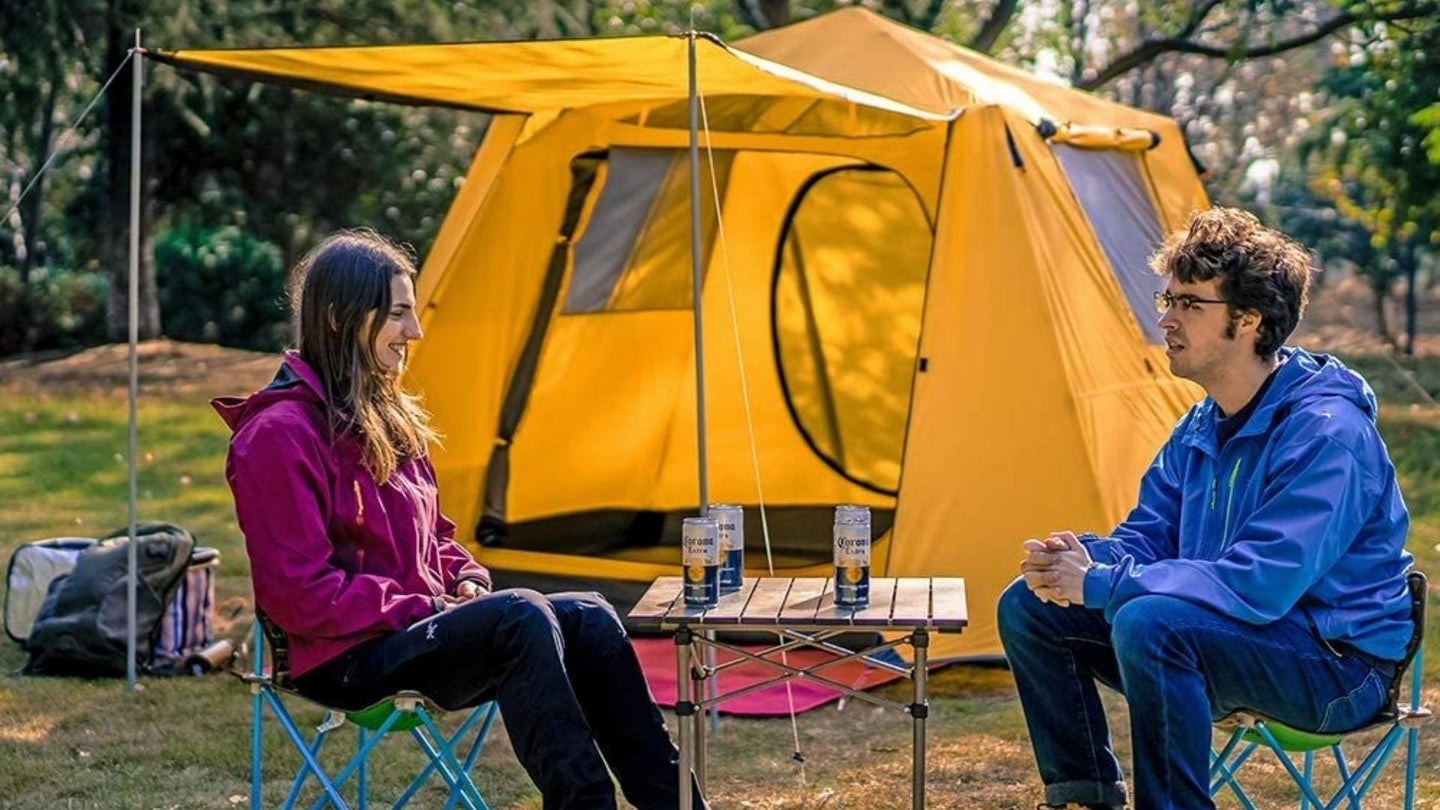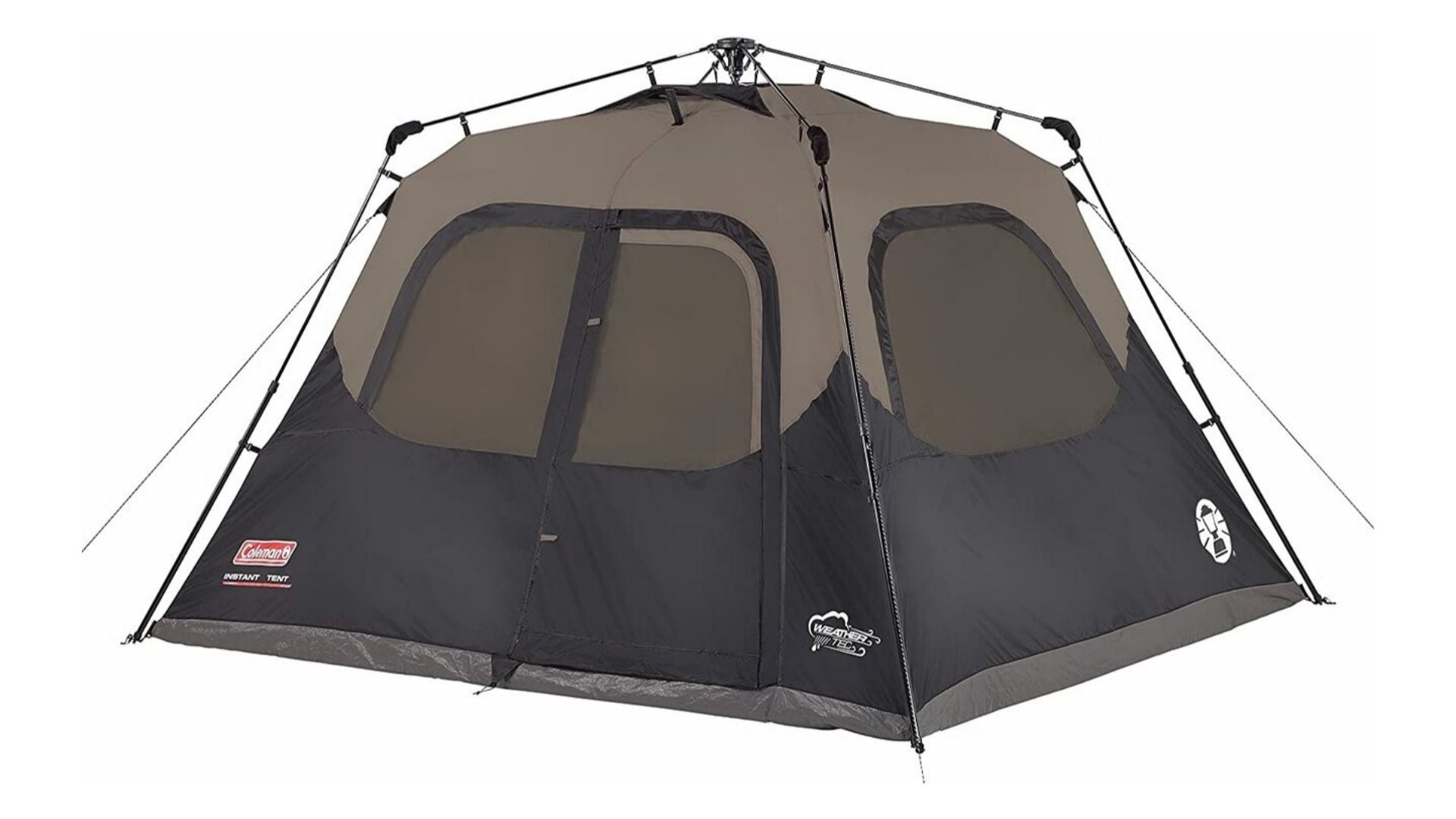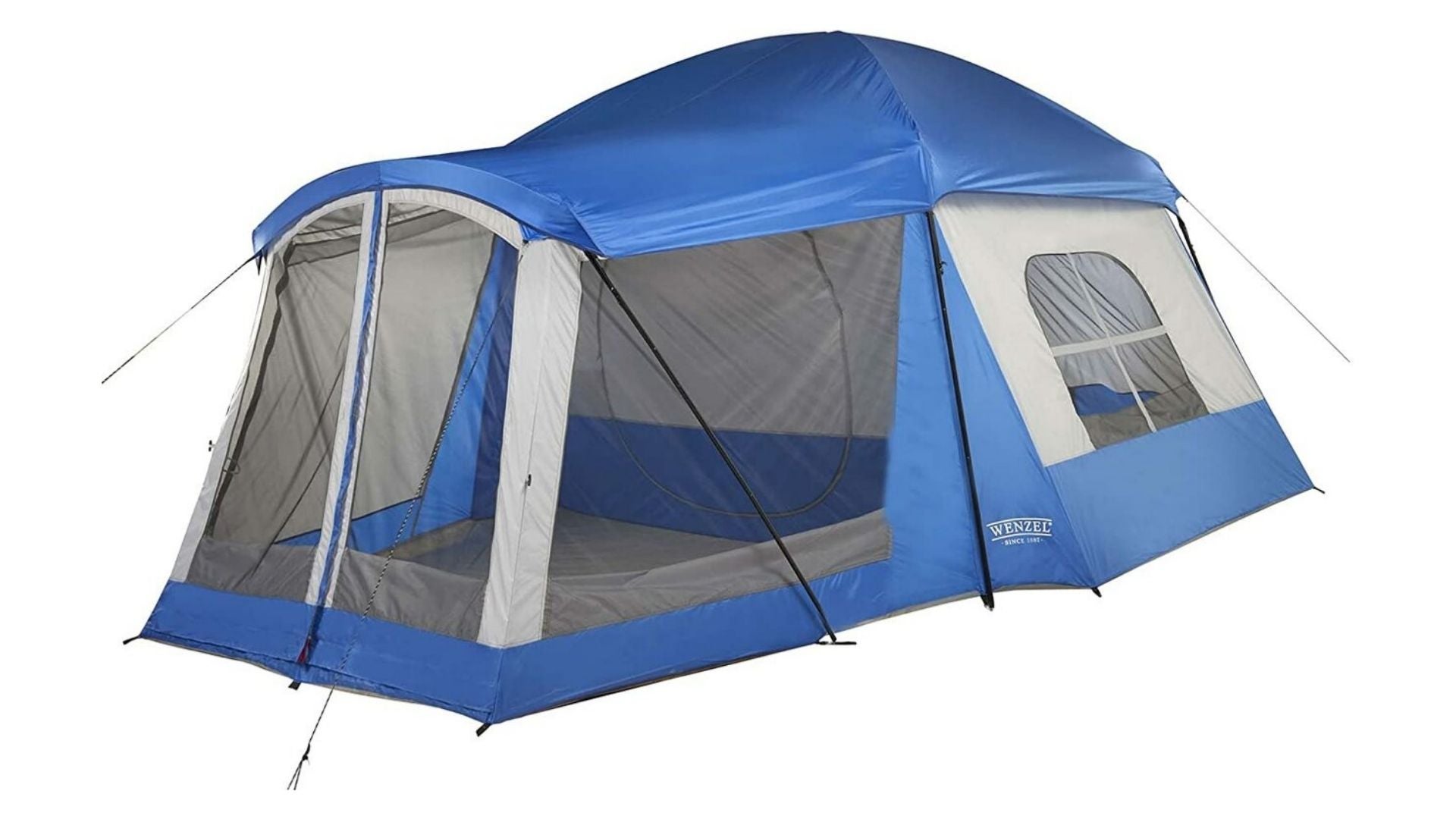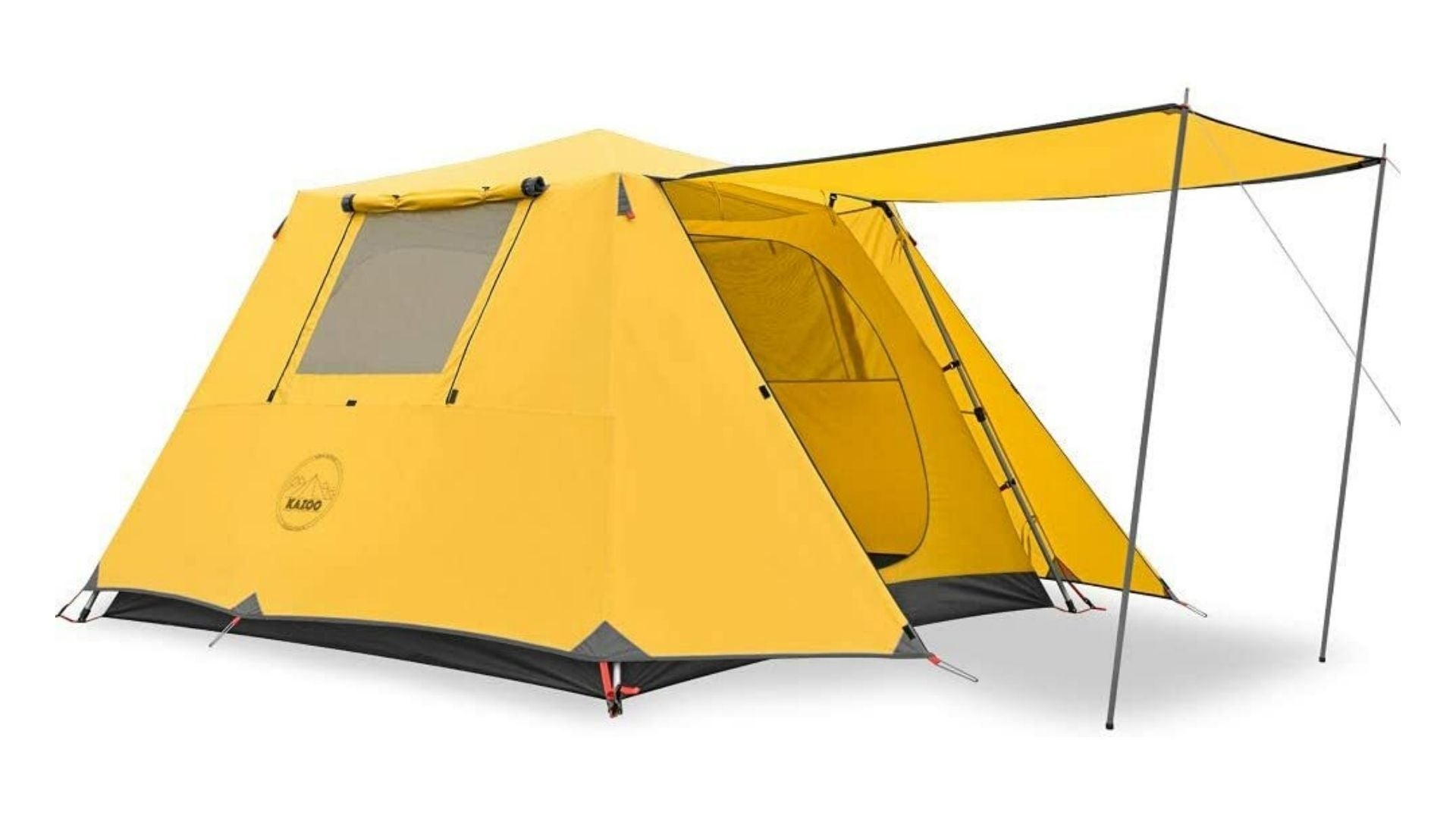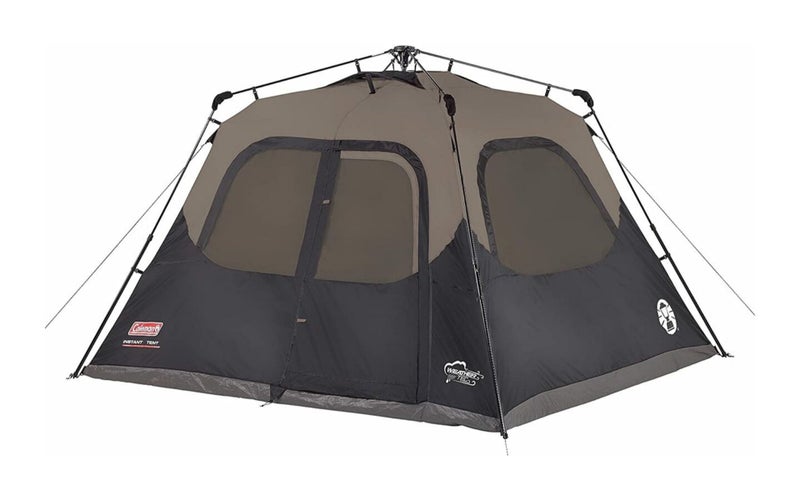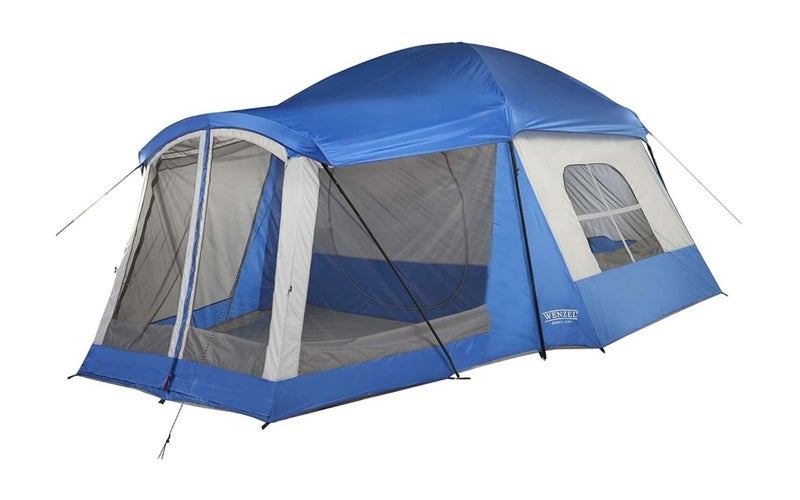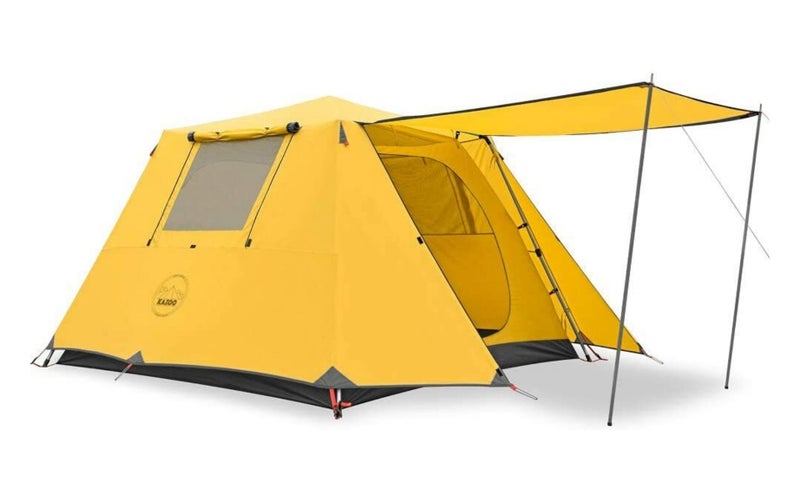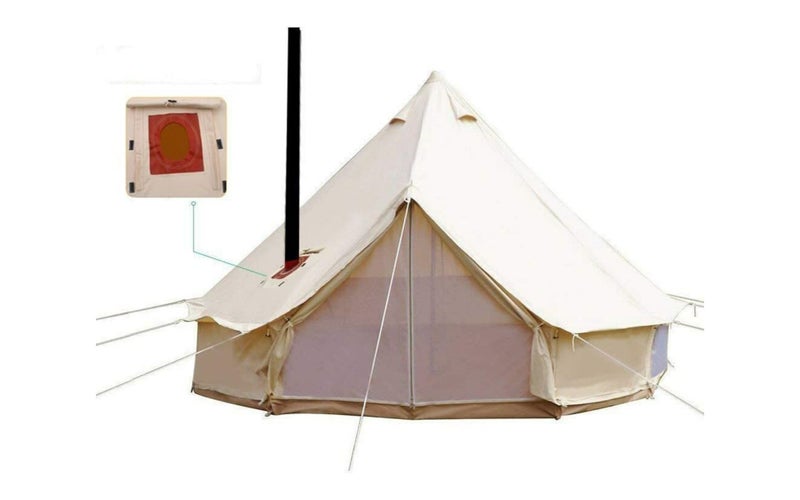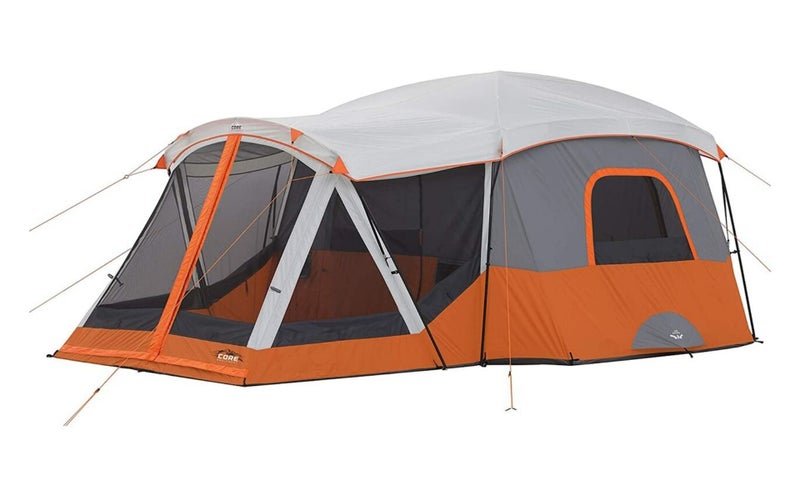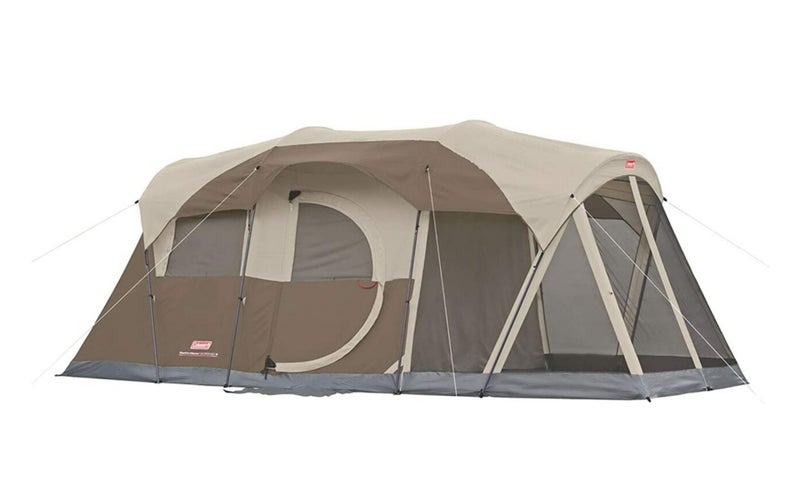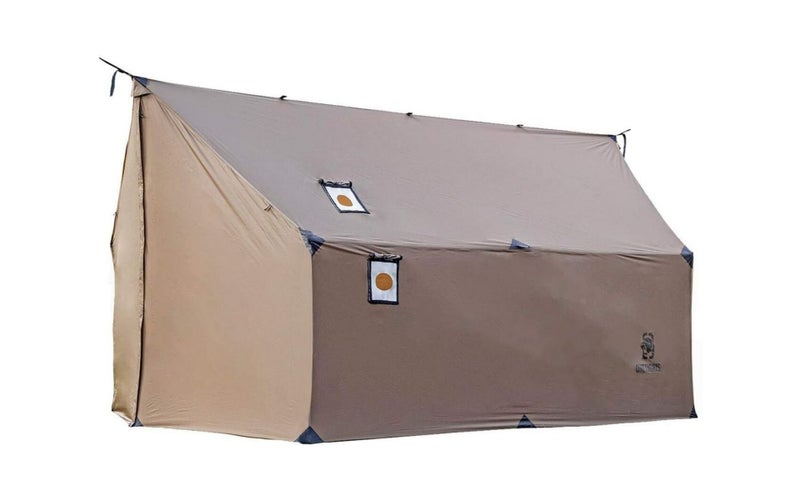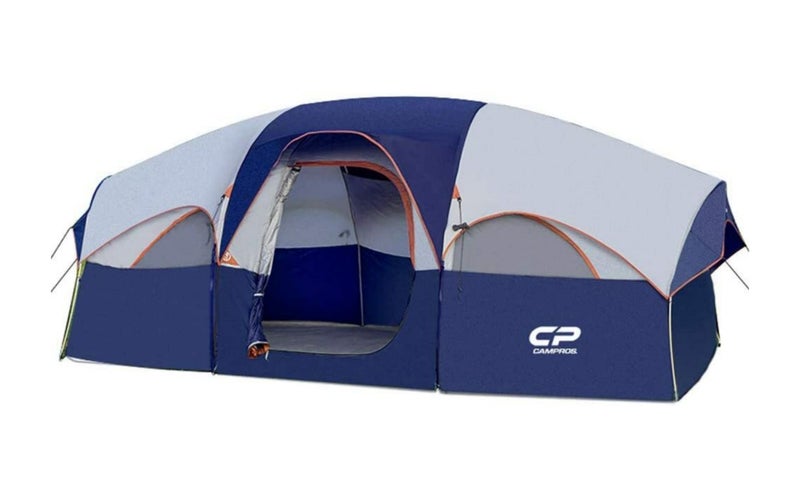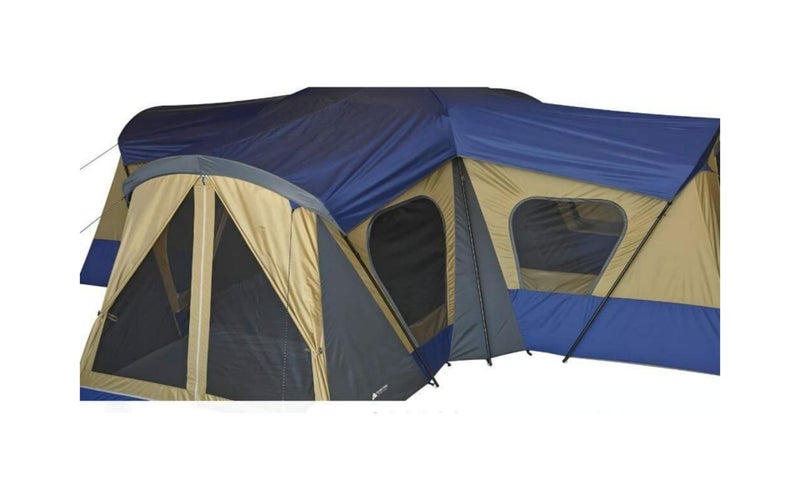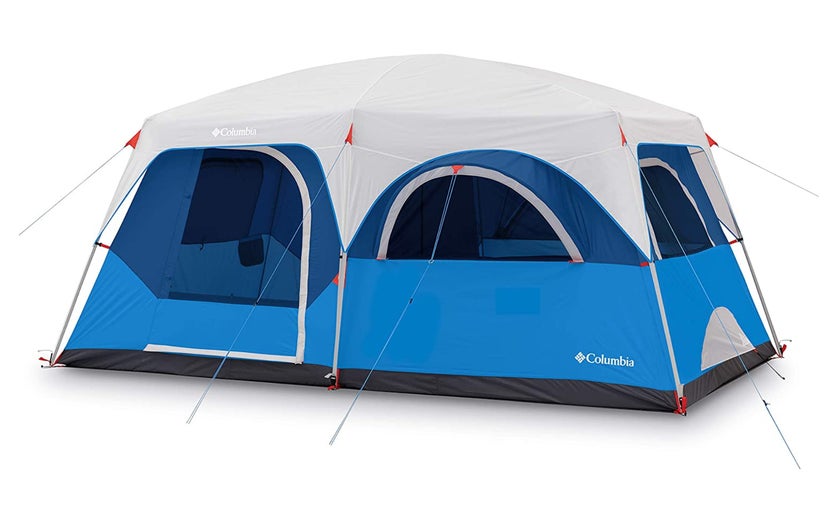We may earn revenue from the products available on this page and participate in affiliate programs.
Sizzling grills and designer-brand coolers get all the glory, but a good cabin tent is the unsung hero of a successful cookout or car camping trip. When you bring your family to a scenic park to celebrate the Fourth of July, Labor Day, or a weekend hotdog sale at your local grocery store, being able to get out of the sun and mosquitos can keep the temperature down in more ways than one. Comfortable, happy kids lead to a much more enjoyable cookout experience.
Even though using a cabin tent probably means you have a few extra sets of hands, transportation and setup will still factor into your buying decision. If you travel with a group of friends, spreading the tent, poles, fly, and other components won’t be an issue, even if you’re traveling by foot. If your family camping trips involve kids, you might want to look at options that are easy to set up with one or two people. Terrain is another factor since dispersed campsites can’t be counted on to be as convenient as the flat, level pads at a campground. Weather and length of stay will determine how hardcore your tent needs to be. Lightweight tents are perfect for most recreational camping, but we found some seriously rugged options that can handle extended stays in all kinds of nasty weather. Some even have room for a stove and chimney.
There are plenty of sizes and styles of cabin tents available, so let us help you narrow down the selection with these top picks from some of the best outdoor adventure brands on the market.
- Best Overall: Coleman 6-Person Cabin Tent
- Best Value: Wenzel 8-Person Klondike Tent
- Editor’s Choice: Kazoo Cabin Tent
- Best Large: Unistrength Cabin Tent
- Best for Tall Campers: Core 11 Person Cabin Tent
- Most Durable: Coleman WeatherMaster
- Best Alternative: OneTigris TEGIMEN Hammock Hot Tent
- Best for Small Groups: Campros 8-Person Tent
- Best for Glamping: Ozark Trail Base Camp 14-person Cabin Tent
- Best for Car Camping: Columbia Mammoth Creek Cabin Tent
Coleman is a leader in outdoor equipment, and the 6-person cabin tent is easily one of the best options on the market. One of its standout features is the Instant Setup, which uses built-in telescoping poles that lock easily and securely into place (and collapse with the press of a button for teardown). My wife and I set this up in about a minute, so it is as easy as Coleman claims on its packaging. Add another minute or two to stake it down and you’re ready to move into your temporary home-away-from-home.
Inside the finished product, you’ll find a 10-foot wide space where, in theory, you can put down two queen-sized mattresses if you want to eat up most of the available room. It’s ideal for a small family or group with, say, two twin-sized mattresses or four sleeping bags and some additional gear. If you go ahead and cram six sleeping bags in there (which you can), you’ll need to leave your extra gear in a vehicle or another tent.
The Coleman 6-person cabin tent is weatherproof, and I made sure to test this. I set this tent up as rain moved in, and slept like a baby in it overnight without the hint of a leak. Plus, the welded corners and inverted seals kept the groundwater out. Made from double-thick Polyguard fabric, it’s tough and durable. Nearly every feature of this tent is ideal for a weekend camping getaway, even if the weather turns foul.
- Size: 10 feet x 9 feet x 6 feet
- Seasons/use: 3 seasons (may not be ideal for winter)
- Setup time/complexity: Simple, about a minute
Built-in poles that snap into place make for extremely easy setup and teardown
Built-in rainfly simplifies setup and adds additional weather protection
Weatherproof
At nearly 27 pounds, this is a heavy tent
Integrated storage pockets are small
The Wenzel company has been around since 1887, and they know a thing or two about making a tent. Spacious, weather resistant, and sturdy, the 8-person Klondike is what makes camping fun.
The setup is somewhat standard, but the roof utilizes fiberglass poles that connect to steel upright supports. It took me about 30 minutes to set up for the first time by myself. Although it is possible for one person to set up, it’s in your best interests to have at least one helper. This is especially the case when putting the rain fly on. The Klondike is tall, and draping the rainfly over it is a challenge even if it is not windy.
Once set up, this tent just looks cool. It not only provides shelter, but the addition of the front screen room distinct from the main cabin is a great feature. The primary living space is 11 feet wide, which offers plenty of room for two queen-sized mattresses, plus room for some gear. Wenzel put a lot of thought into making this tent breath, too. It has large mesh windows, mesh openings at the top, and a mesh vent at the back to keep air flowing.
Like most tents, the Klondike uses a removable rainfly to keep out the elements. The tent is made of Weather Armor polyester fabric and utilizes double-stitched seams, which does well in rain. However, some customers report leakage in continuous heavy downpours, so it’s probably a good idea to use some Scotchguard to waterproof the rainfly for extra protection.
- Size: 16 feet x 11 feet x 6.5 feet
- Seasons/use: 3-season
- Setup time/complexity: Moderate, about 20 minutes first time
Lots of room
Weatherproof
Front screen room can fit up to three sleeping bags
Large tent area is great, but not ideally laid out for eight campers
Screen room is a good half-a-foot shorter than main cabin
Only two accessory pockets on walls for up to eight people
If you imagine your ideal cabin tent, this one from Kazoo probably comes pretty close to fitting that description. A rip-resistant, waterproof polyester fly is tough enough for life in the outdoors and will keep you dry when the weather turns on you. The main tent’s mesh sides let you enjoy a panoramic view and fresh air. A fold-out awning shields the entry from sun and rain.
This tent opens like an umbrella, so setup is quick and easy for a single person. The aluminum frame is lightweight and won’t rust. Once pitched, the four person tent is a little small for a cabin tent, standing 61 inches (just over 5 ft), but the larger 6-person version has a peak of 73 inches. The Kazoo weighs in at 17.5 pounds and is made of 210T Ripstop fabric, which is both waterproof and breathable. At 10 feet wide, it can accommodate (snugly) two queen sized mattresses and some gear (though you’ll probably want to leave your bulkier items in your vehicle if you have two mattresses). The carrying case contains the tent, 10 guylines, 18 stakes, and a hammer. The whole package is four feet long, so you’ll definitely want to drive it to your campsite.
- Size: 10 feet x 9.18 feet x 6.07 feet
- Seasons/use: Summer
- Setup time/complexity: Simple, under a minute
Easy to set up, with its pop-up aluminum frame
Waterproof double layers (interior polyester, rainfly ripstop polyester)
Spacious enough for 6 people, or a family of 4 with gear
Mesh sides offer no privacy without the rainfly
4-person version is barely over 5 feet high
When you want the ultimate cabin tent experience, check out this masterpiece from Unistrengh. This roomy vacation getaway is more of a second home than a tent. Sizes as small as 10 feet in diameter are available, but we love the idea of the 23-foot portable palace.
The Unistrength Cabin Tent is actually a yurt-style tent. Even the smallest of these, at three meters in diameter, is heavy and weighs around 44 pounds, while the largest jump to over 100 pounds. The tent material is waterproofed cotton, which has a pipe vent that is surrounded by fireproof fiberglass fabric. The floor of the tent is a waterproof ripstop PVC material. The Unistrength’s rugged construction and steep roof are suitable for all seasons. There’s even a place to install a chimney for a wood-burning stove.
The tent comes in a cloth carrying bag along with a center pole, a frame for the door/entrance, and ropes and stakes for tying it down. And as large as these things are, setup is relatively straight-forward. One person can set it up in about 30 minutes, but having at least one extra person assist will help you keep your sanity.
Waterproof canvas keeps you sheltered against rain and snow, while windows and the roll-up walls let in light and fresh air when the weather cooperates. The PVC floor is waterproof and strong enough to hold up to extended use. The price and size of this tent make it a stretch for most campers, but for the most luxurious outdoor adventure or even a rental or guest house, it’s just about perfect.
- Size: 23 feet x 13 feet
- Seasons/use: 4 seasons
- Setup time/complexity: Moderate/30-45 minutes
Massive, can accommodate 10 campers or more
Stove hole and electrical wire inlet
Bottom can be zipped up, providing 360 angle view
Waterproof 300g per square meter cotton material
It’s heavy, with the largest version weighing over 100 pounds
Expensive
The Core 11 cabin tent is rated for 11 people — and they do fit — but we like to think of this as a high-end escape for outdoorsy couples. The front screen room is large enough to sit and enjoy your dinner away from the bugs with a 180-degree view. It’s also a handy place to keep your gear at night.
This sharp looking tent comes with a carry bag, and includes everything you need to set up: tent, poles, stakes, and rain fly. Setup is like other conventional tents, by sliding flexible poles through sleeves and connecting to the support poles. You probably want at least two adults.
Once you erect the cabin, the front screen room pops into place pretty easily. Note that if you intend on using the front screen room as an area for campers, there’s only one way into the main cabin, and that’s through the screen room.
The main area of this tent is large enough to fit two queen mattresses (if you’re generous enough to share), while you can squeeze another queen mattress into the front screen room if you need. A gear loft provides storage for small items where they can hang to dry and stay out of the way. For those tall campers who hate having to slump while inside, this tent is awesome. The center peak is 86 inches tall and makes this cabin tent feel incredibly roomy.
Enjoy stargazing with the see-through roof during nice weather, and button-down the waterproof rain fly when you need more shelter. This cabin tent is more expensive than some alternatives, but the premium features are well worth it.
- Size: 17 feet x 12 feet x 7 feet
- Seasons/use: 3 seasons
- Setup time/complexity: Moderate, about 20-30 minutes
Huge main cabin
Seperate screen room for lounging, gear, or extra campers
Electrical access port for a little extra luxury
Water resistant and durable
Integrated gear loft
Heavy. Drive this to your campsite
Huge main cabin could use a divider for privacy
Larger groups owe it to themselves to consider Coleman’s WeatherMaster cabin tent. This 6-person size provides 99 square feet of sleeping space, enough for two queen air mattresses, and a 54-square-foot screen porch. While the 10-person size doesn’t include a porch, it does have 153 square feet of interior space that can fit three queen air mattresses. Both sizes boast an 80-inch center height that accommodates even the tallest campers.
This tent comes in a four-foot fabric bag and weighs 32 pounds, so it’s on the heavy side for a 6-person tent. The tent uses three sets of color coded steel poles (one set on each end and one in the center) for upright support as well as shock-corded fiberglass poles for the unique hinged door. The tent structure is a little more complex than others, and so to minimize frustration, have a friend help put this together.
As the name implies, this tent is designed to protect against the elements. Inverted, sealed seams keep water from entering from the ground, and a waterproof rain fly protects the tent’s exterior. The tent itself is made from a coated polyester fabric (68-denier mesh), and the rainfly is a 75-denier polyester.
Setting up this cabin tent is probably more involved than you’re used to, so get some helpers and expect to spend about 20 minutes pitching it. Once you’re done, you’ll have one of the best cabin tents around.
- Size: 11 feet x 9 feet x 7 feet
- Seasons/use: 4 season
- Setup time/complexity: Moderate, about 20-30 minutes
Made for all seasons
Separate side screen room for lounging or extra campers
Electric power port for extension cord use
A little complicated to set up
Screen room is floorless
Looking for a way to set up a roomy tent but don’t want to lug 25 pounds of excess weight into the woods? Try a hammock-style tent. One of the bulkiest components of tents is the poles that form the frame, and this tent from OneTigris gets rid of those altogether. Without poles, it takes up less space and keeps your camping load lighter.
Without poles, the TEGIMEN is the lightest of all the tents on this list, weighing less than seven pounds. The TEGIMEN, made of 70-denier ripstop nylon, is waterproof (rated at 3,000 millimeters) and made for all seasons. The tent comes in a fabric bag along with stakes and guylines for you to secure the tent between trees (although you can purchase poles if you want, but then you just defeated the purpose of this style of tent). If you want to use it in the winter, the TEGIMEN has two stove jacks (one on the wall, one on the top of the tent), which gives you some flexibility on where you can set up a stove.
Many wilderness shelters start with a tight line between two trees, and this style of tent uses the same approach. Stretch guylines out from the corners to finish setting up the tent. Zippers in the corners also let you set up a hammock on the same trees to create an instant bed. Bring along a camp stove to take advantage of the chimney exits and stay warm during the cool seasons. Accessories like hammock quilts and a tent floor are available. Remember that the frameless design makes this tent reliant on trees.
- Size: 12.5 feet x 6.6 feet x 6.2 feet
- Seasons/use: 4 season
- Setup time/complexity: A little tricky in that you need properly spaced trees
Super lightweight
Waterproof and made to retain heat
Plenty of room for a cot/hammock or two
Stove jack ports
Hammock not included
Less conventional setup
When you need space for a large family or you have a group of folks sharing camping space, you should take a look at the Campros 8-person tent. It’s spacious enough for two queen mattresses plus a twin mattress (the product page claims three queen beds will fit, but based on my own testing, I disagree). If you have up to nine people, ditch the mattresses and bring in the sleeping bags, because you can cram in nine of those if need be. Plus, you can set up a fabric divider to make two separate rooms for a little extra privacy. It’s palatial for a small family, and offers plenty of room for a couple of small groups (say, 2 small families sharing the tent).
This tent comes in a two-foot fabric bag, which is half the size of most cabin tents. Plus, it’s incredibly light compared to other tents, about 18 pounds. The lightness is partly because Campos uses only flexible fiberglass poles, no steel or other metal upright support. The poles snap into place and are inserted through the stitched sleeves sling the top of the tent, and are then locked into pins at the base of the exterior. Two people make this a breeze, and one person can do it and only take a few more minutes.
The inner tent and the rainfly are both made of 185T polyester, and are rated to 1000mm, which Campros guarantees will stand up to light rain. An e-port is provided for extension cord use, and the walls have a couple of mesh pouches for accessory storage. This 8-person tent is durable and well designed. The large mesh windows will keep the air flowing, which is fantastic since having a group of folks camping in a tent can be, shall we say, a little challenging in the odor department.
- Size: 14 feet x 9 feet x 6 feet
- Seasons/use: 4 season
- Setup time/complexity: Simple, under 10 minutes
Lots of space for plenty of people
Fabric room divider offers some privacy
E-port for extension cord use
Weather proof for light rain
Double check the fiberglass poles (two spots were damaged on the one I tested)
Protective fabric lining door seam tends to get caught when zipping open/closed
Some folks might want to go camping, but hate the idea of being holed up in a nylon rectangle for a couple days, especially with a lot of other people. If lack of privacy and the austere nature of many tents is turning you off from camping, then maybe you should consider “glamping” (where “glamor” and “camping” come together). The Ozark Trail Base Camp 13-person cabin tent just might make you think you’re staying in a portable home.
This huge tent is shaped like a compass, with four distinct rooms that branch off a central area. Fabric dividers can be set up for each of these, enhancing privacy. Each room has a door to enter and exit the tent without walking through the other areas, so each room is almost its own separate tent. Up to 14(!) queen-sized mattresses can pack into this thing.
Despite the large size, this tent is set up like most other cabin tents. It uses flexible fiberglass poles for the roof sections and steel poles for upright support. When setting up, you want to start with the center, then move to the rooms that branch off from there. The rainfly simply sides over the whole thing and is secured by shock cord to the steel uprights. It’s surprisingly simple.
This tent isn’t meant for hiking up a mountain or pitching in the wilderness. It’s meant for fair weather camping, in a place with a lot of space. Be sure to treat it with weatherproofing spray before you head out.
- Size: 20 feet x 20 feet x 6.5 feet
- Seasons/use: 2 seasons
- Setup time/complexity: Moderate, 20 minutes
Crazy big. If you buy this, you want space, and this delivers
E-port for extension cord access
Relatively simple to assemble, considering the size
Primarily for warm weather use
Very heavy (50lbs)
Stakes are kind of flimsy
Part of the popularity of car camping comes from the ability to venture further from home in pursuit of a picturesque getaway, and a Columbia Mammoth Creek cabin tent can help you get a more restful night’s sleep after a day in the car. It’s sturdy, protracted from the elements, and adaptable to suit whichever campsite you choose.
While this tent is too big to carry very far on foot, it’s surprisingly light for its size at just 28 pounds. Once raised, it’ll offer 112 square feet of floor space and a peak height of more than six feet. Beefy structural components help keep the tent strong in the face of wind, but lightweight materials prevent it from becoming unwieldy during set-up and tear-down. Columbia also included lots of mesh for great views and cooling airflow, although you have the option to zip windows closed and attach a solid roof cover for privacy and protection from the elements.
Some features are hard to spot but make a big impact. This tent benefits from treated fabric that repels water and dries faster than untreated material. The tub floor keeps water from seeping in from below, and taped seams keep the rain at bay. Technically, this is an eight-person tent, but it can also accommodate an air mattress in each of the two rooms, which sounds a lot better than most camping experiences.
- Size: 14 x 8 x 6.3 feet
- Seasons/use: three seasons
- Setup time/complexity: moderate, 15-30 minutes
Very rugged and solidly built
Sleep under the stars or install the protective roof
Screened-in windows can be covered for privacy
Larger and smaller sizes are available
Very bulky; you’ll want to park close
Commands a higher price than a lot of cabin tents
Why you should trust us
Task & Purpose has no shortage of gearheads who love the outdoors. Our personal experience started before I joined the military, and over the years I’ve camped in the Smoky Mountains, the hills of Kentucky, Tennessee, and the Chugach mountains in Alaska. Most of the tents you see above were individually tested. Those that we couldn’t get inside, we critically reviewed product information and paired that up with customer reviews to give you as much information as you need to make a good choice.
Types of cabin tents
Traditional
This is like your dome tent’s dad, in that it’s made in a similar fashion, just with longer, stronger rods and (usually) heavier fabrics. Compared to normal camping tents, cabin tents are much more upright and provide more space. While all the cabin tents on our list are roomy and well-built, their sizes and features are what make them unique. You can find normal tents for a single person, but the smallest cabin tents are meant for groups of four. You can always take advantage of that size to give one or two people more room, but don’t expect your cabin tent to be quite as portable or compact as a traditional alternative. Cabin tents also differ from one another in their intended length of stay. Most are designed for short-term use. Others are much more robust and can be used year-round; just remember that setting them up is quite a task.
Hammock
This is arguably not a cabin tent, but can be as roomy so we’re including it here. These tents use an old fashioned method of hanging from a line suspended between either poles or trees, with the walls pulled away, creating a long peak down the middle. These are light, and can be more easily used in more remote areas, but aren’t as secure as a traditional cabin tent.
Yurt
This style is picking up some popularity of late. Yurt tents are modelled after the portable, circular yurt dwellings of ancient Mongolia. They’re spacious, and easily set up and broken down. Typically a central pole lifts the center high, and the circular wall drapes down all around. These typically also use treated cotton type cloth (vs the synthetic fabrics most other kinds of cabin tents use).
Key features of cabin tents
Size
Since cabin tents are more about shape than size, you can find one that’s just right for you. Start small with a tent for four people, or bring the whole group with a 12-person tent. For utmost comfort, I divide the max number of people a tent can hold by 2 (so for my 3-person family, I use at least a tent for 6 people). That gives you room to sleep and have gear.
Intended use
One of your main considerations should be the duration of your camping trips. Most cabin tents are well-suited to weekend or vacation camping, but a few have the potential to serve as a long-term getaway. Those designed for extended use tend to be more costly.
Portability
Cabin tents are incredibly useful, but they’re not for everyone. If you plan on trekking into the wilderness, you’re better off with a traditional camping tent. If you can travel by vehicle, a cabin tent can be a major upgrade to your campsite.
Setup
As you might imagine, setting up a cabin tent can be a little more involved than a normal camping tent. Most tents are similar, so once you set one up, you’ll be familiar with others (but read the directions anyway! Those minor differences can make all the difference between a quick setup and a prolonged headache). Get the rest of your group to pitch in with setup and tear-down.
Benefits of cabin tents
Size
Cabin tents’ biggest advantage is interior space. If you can live with the extra weight and size on the way to the campsite, you’ll enjoy a tent that’s large enough for most people to stand comfortably in. Not having to high-crawl in and out of your tent is a perk that you’ll definitely appreciate once you experience it. Many come with extra features like awnings, screen windows, and multiple rooms. These perks make them an excellent choice for families who want to spend time together outdoors.
Amenities
This is usually dependent on how much you’re willing to spend, but many cabin tents are made to coexist with some modern amenities. Things like dividers for privacy (effectively making separate rooms), access ports for power lines, and even fireproof vents for stoves.
Pricing considerations for cabin tents
Cabin tents certainly aren’t cheap, but they’re built from quality materials and make campsite life a lot more comfortable.
Inexpensive ($100 – $150)
Four-person tents start around $100 for basic amenities and go up to $250 for higher-end options. It’s a good bet that tents in this range are only water or weather resistant, so you definitely want to apply some waterproofing and sealant to the seams.
Mid-range ($150 – $250)
Tents built for groups of six to 12 cost anywhere from $200 to $350, depending on which features you prioritize. These tents will typically use fabrics better treated to withstand water, and often incorporate things like screen rooms and e-ports for access to electricity.
Premium ($300+)
The most advanced, long-term cabin tents cost up to $1,000. At that price, you’ll get four-season lodging that could serve as a second home in the right situations. Note that these more costly tents aren’t getting any lighter, or necessarily easier to put together. You’re really buying more space, and more durability. These heavier tents may also support stove use as well.
How we chose our top picks
The tents that made this list are some of the best, most highly rated tents that we could find. They had to promise lots of space, relative ease of setup, and durability, to include weather resistance and/or waterproofing. Once we had a list of candidate products, we reviewed customer reviews to see which had solid testimonials as to quality and useability. Whenever possible, we then got our hands on the actual product to see how these tents performed in the real world.
FAQs on cabin tents
You’ve got questions, Task & Purpose has answers.
Q. How do you set up a cabin tent?
A: Most cabin tents are very similar in setup, and consist of poles and rods (often fiberglass) that create a frame to support the outer fabric. Stakes are used to secure the tent to the ground, and more stakes used with guylines to help spread out windows and the rainfly. Be sure to follow the directions provided by the tent makers. When you get a new tent (or are gifted a used one), always set it up completely at home before using it for camping. You don’t want to find out that there’s a huge gash in it, during a rainstorm while on vacation
Q. What is the purpose of a cabin tent?
A: A cabin tent is a great way for a family or group of people to camp together at an established or easy to get to camp site. They’re designed to be much larger and a little more sturdy than dome tents, which are smaller and designed to be carried into more remote locations.
Q. Are cabin tents waterproof?
A: This varies from tent to tent, but many are not actually waterproof. Most are “water resistant”, so they can hold up to a light rain for a while, but will eventually start to leak. Always check the tent’s product page when you buy to understand what kind of waterproofing/resistance your tent has. A waterproof rainfly (which is often, but not always, included) is a great way to increase a tent’s ability to keep out precipitation.
Q. Do cabin tents lose their waterproofing?
A: Yes. The amount of use and type of weather you expose your tent to will have an impact on how often you should re-waterproof it. It might seem a little counter-intuitive, but if you find yourself often camping in areas that expose your tent to little rain but lots of direct sunlight, you’ll need to re-waterproof it before too long. The sunlight can actually break down or dry out the tent’s waterproofing. For regular use, think about applying a waterproofing agent every couple of years.
